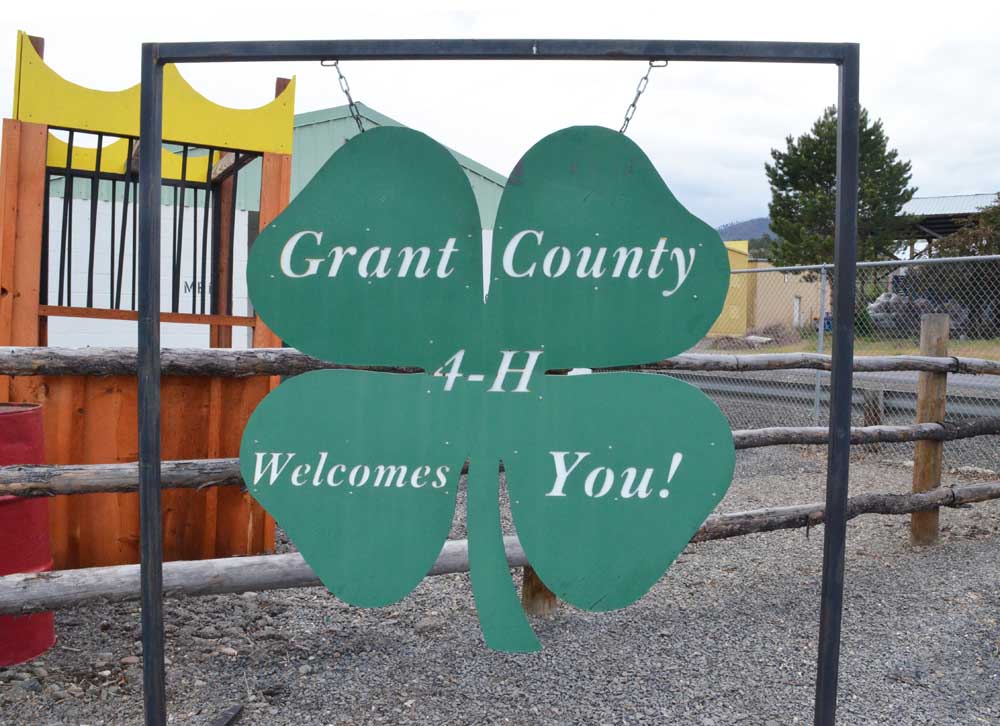PROGRESS: Grant County overcomes challenges to improve services
Published 12:15 pm Thursday, June 27, 2019

- A sign at the Grant County Fairgrounds promotes 4-H clubs.
The challenges facing Grant County are clearly economic. Loss of timber mill jobs has impacted all sectors of the local economy. But there are successes. County government continues to provide for the health, safety and welfare of the area residents, balancing budgets and keeping up critical infrastructure.
Trending
Tough numbers
Grant County’s population has been declining since the 1990s. This pattern is projected to continue, according to the most recent forecast by the Population Research Center at Portland State University.
Nearly all the cities in Grant County have experienced a similar population loss since 2000, but the decline has stabilized since the Great Recession and remained fairly steady since 2010. At the same time, the county’s population is aging, with a trend toward more residents over 70, and the active labor force has a somewhat lower educational attainment level than the state, according to U.S. Census data.
According to data in the May 2019 draft Economic Opportunities Analysis report by Johnson Economics, cumulative employment growth since 1998 for the U.S. and Oregon has been about 25%, while Grant County has seen a decline of 15%.
Employment in the county peaked in the mid-1990s at more than 4,550 jobs, or an estimated 1.35 jobs per household, the report states. Since then, employment has consistently fallen, reaching an estimated 3,780 jobs in 2017, or about 1.2 jobs per household.
Local employment is also seasonal, reflecting agricultural and forest-related industries. The Grant County employment base also has a higher share of self-employment compared to the U.S. and Oregon, including agricultural and owner-operated businesses, the report states.
Unemployment in Grant County tends to be 2-3% higher than the U.S. and state averages, but this elevated unemployment rate persisted until 2013 following the Great Recession, lagging far behind the national recovery, the report states.
The timber and forest-related industry has been a significant economic driver in Grant County, with local employment in natural resource jobs running nearly six times the national average, the report states. But this local economic sector has seen a sharp decline, which is largely attributable to falling production on public lands since 1993, the report states.
Working residents in Grant County commute to jobs inside and outside the county. Local residents hold about 73% of the available jobs in the county, while about 39% commute outside the county for work. While John Day accounts for about 23% of the county’s population, about 63% of the jobs are in John Day.
As a result of the general population decline, the county has seen little development activity since the 1990s. Grant County Judge Scott Myers said lack of affordable workforce housing and family-wage jobs is a significant challenge for the county.
New housing starts in the county definitely have slowed down from the busier 2006-2008 time period, Grant County Assessor Dave Thunell said. His office reported 25 new “stick-built” single-family residences and 16 manufactured homes on Jan. 1, 2008, but only eight “stick-built” homes and four manufactured homes on Jan. 1, 2018.
According to the Grant County Planning Department, 33 commercial building permits were issued in 2014 worth $1.3 million and 44 residential building permits were issued worth $3.3 million. The numbers for 2018 were 23 commercial permits worth $2 million and 47 residential permits worth $6 million.
County projects
Roads and bridges in a 4,500-square-mile county with just 7,400 people can also present a significant challenge. Myers said the county tries to chip-seal 40 miles of county road each year.
This year’s chip-seal project will take place on a county road near Silvies Valley. Some older bridges present challenges, including ones near Long Creek and Monument, Myers said.
Myers points to recent projects at the courthouse as local successes. Fluorescent lights have been converted to energy-efficient LED fixtures, and an elevator installed in 2016 will help the public facility meet ADA-compliance regulations.
The Legislature provided the county with about $150,000 for the elevator project, and the county put up about $70,000. Re-roofing the courthouse could cost from $100,000 to $150,000, and Myers said he has requested help from Association of Oregon Counties to lobby legislators for assistance in this project.
Maintaining and repairing existing courthouses is more cost-effective than building new ones, Myers said, noting that Deschutes County was looking at spending $30 million for a new courthouse.
The same goes for the county jail. Built in 1997, the facility has 41 hard beds and options for up to seven more temporary beds. The daily jail population rarely exceeds 20 inmates, according to the county website. An upgrade to LED light fixtures is currently underway.
Last year, the county court approved spending about $4,500 to install a new time-keeping hardware and software system. The upgrade will help the county secure contracts to house inmates from other jurisdictions, Commissioner Jim Hamsher said last year, and the county’s insurer offered to cover some of the costs as it reduced liability.
Unfunded mandates
Hamsher sees Eastern Oregon’s weak position in the Legislature as a serious challenge for Grant County. He cited proposed carbon cap-and-trade legislation and stricter firearms regulations.
“Our voice is not big enough,” he said. “That’s why the court sends letters in support or opposition to bills.”
He also cited unfunded mandates by federal and state governments. One example is building permits, where plan reviews sent to Salem can be held up for four months or more, he said.
Hamsher sees some successes in the local timber industry, with construction moving forward on a new torrefaction plant at the Malheur Lumber Co. mill in John Day.
The torrefaction plant will help address fuel reduction projects that might help prevent wildfires in the national forest, but he’d also like to see biomass from thinning projects used to restart the co-gen power plant at the closed Prairie Wood Products mill in Prairie City.
He also cited the Forest Service’s decision to take a second look at the Blue Mountains Forest Plan Revision.
“There’s too much bug kill without timber harvest,” he said.
Grazing restrictions presented in the Forest Plan needed to be relaxed, Hamsher said.
“Grazing should be seen as a tool to reduce wildfire hazards,” he said. “Cattle are like mini-weedeaters, but without the PERS cost.”
A new county program on tax-foreclosed properties will make a positive impact on housing, Hamsher said. The legal process has been expedited to make properties available to builders and put the properties back on the tax rolls. He cited a burned home in Prairie City that had been an eyesore for several years, and three other properties in the city where new single-family homes could be constructed.
Hamsher praised the hard work by Ted Williams, the county’s emergency management coordinator, and Deputy Dave Dobler, who heads up the search and rescue program. They both proved critical during this past spring’s floods.
He also noted that the county was very fortunate to have so many dedicated volunteers.
“We couldn’t do half the things we do without them,” he said.
County fairgrounds
Possibly one of the county’s greatest successes is the Grant County Fairgrounds, which has a lengthy history but has been seeing upgrades by the county and volunteers alike.
“We have a wonderful facility, and everything is close by,” Fairgrounds Manager Mindy Winegar said.
First impressions are important, and that means keeping up the Grant County Fairgrounds, Hamsher said.
“This is where many people go when they come here,” he said.
The Fairgrounds is partially self-sustaining, Winegar said. Last year, it received $25,000 from Oregon Lottery funds through the county and $55,000 from Lottery funds through the state. But that $55,000 was a one-time figure — it’s fallen back to $53,000, Winegar said.
“It costs $110,000 to put on the fair,” Winegar said.
The fairgrounds makes up the difference with ticket sales at events, sponsorships and a percentage of revenue from the RV park. About 13,000 people attended the 109th county fair last year, and more than 8,000 visitors spent more than 3,500 nights at the RV park, Winegar said.
The fairgrounds hosts a wide variety of events. More than 2,500 people attended yard sales and workshops, and about 800 people attended meetings of the Oregon State Snowmobile Association, Rocky Mountain Elk Foundation, Iron Triangle Holiday Party and the Blue Mountains Forest Plan Revision objection process.
Last year, more than 2,000 people attended benefit dinners and memorial services at the fairgrounds; about 1,500 people attended the Strawberry Mountain Gun Show, Spring Bazaar and Christmas Bazaar; youth events drew more than 1,500 people, including the Cinnabar Mountain Playdays rodeo series, Calvary Horse Camp and JC Oliver Memorial Roping event; and the annual quilt show drew more than 400 people.
More than 900 people attended the NPRA Rodeo, and about 300 people attended the Ty Evans Mule Clinic and Joe Wolter Horse Clinic. Other events include the Kentucky Derby Viewing Party, the Whiskey Gulch Gang’s Demolition Derby and the annual Civil War football game gathering.
The fairgrounds is also a favorite destination for groups that enjoy traveling Eastern Oregon’s scenic byways. Four separate bicycle tour groups brought more than 1,000 visitors to the fairgrounds last year. The annual BMW Riders of Oregon brought about 480 visitors.
“During fair time, you cannot get an RV spot or motel room anywhere near John Day,” Winegar said.
Keeping up with infrastructure needs at the fairgrounds is an ongoing task. Winegar said 10 of the RV Park’s 25 picnic tables have been replaced with low-maintenance, 300-pound metal models. She hopes to see new parking lot lights installed in time for the fair. She has received approval to remove several giant cottonwood trees behind Trowbridge Pavilion — the tree roots had uplifted the pavilion’s concrete floor, which will need a major repair.
A major project is to upgrade Keerins Hall. The older building was re-roofed last year, but it needs new siding, doors and windows. Once the exterior is fixed up, plans can go forward for a major interior remodel, Winegar said. Fundraising for that work has started with sales of an 18-month historical calendar, available at the fairgrounds and the Grant County Chamber of Commerce.
Winegar would like to see additional spaces at the RV park and increased security features around the entire facility. Fortunately, the Grant County Family Heritage Foundation has taken on the task of upgrades at the Heritage Buildings, including increased electrical capacity and ceiling “misters” to help cool the building in summer time.
Regional airport
Not many rural communities can claim an airport facility like the Grant County Regional Airport. It started small in 1961 with one 4,500-foot runway and a 1,500-square-foot home serving as the terminal. Increased need by the Forest Service for firefighting aircraft spurred new projects at the airfield, which now has two runways and a modern terminal.
Runway 9/27 was extended 950 feet in 2008 and rebuilt in 2014. Runway 17/35 is 60 feet less than a mile long, a “magic number” for aircraft safety concerns. But lengthening the runway an additional 60 feet may be difficult because of steep terrain and public roads.
The $5.4 million terminal was completed in 2010. The Forest Service, which had been operating out of several deteriorating and cramped modular buildings at the airport for more than 30 years, now occupies the second floor of the 17,752-square-foot terminal. Taxiways already exist for development of future hangars north of the main terminal.
A two-year process is underway to develop a 20-year master plan for the airport. The 20-year plan is conceptual only and must go through a public process. T-O Engineering of Boise, Idaho, which worked on the plan, accepted input from pilots, the Forest Service and other community stakeholders since 2015 to determine what type of airport is needed, based on the kinds of aircraft that have used the airport in the past and might use the airport in the future.
In May, the county secured a $6.25 million grant through the federal Department of Transportation’s Airport Improvement Program with no match required that will be used to “decouple” the two runways and make takeoffs and landings safer. Final design and planning for the decoupling project will take place this year, and construction could take place in 2020, Airport Manager Haley Walker said.
In the meantime, repairs to deteriorating aprons around the hangars could take place this year. Prop wash from powerful planes, such as the Forest Service’s single-engine air tankers, often kicks up the gravel from the crumbling aprons that can damage other aircraft. Design and engineering for the apron project cost about $522,000, with the county picking up about 1% of that cost.
Public services
Mass transit is not a common sight in frontier communities like Grant County, but the People Mover has been a success story. The county’s public transportation system grew out of the People Mover program associated with the John Day Senior Center in the 1970s.
The current district was formalized in 1992, and the bus barn was remodeled the next year. The program has grown since then to eight vehicles, providing service along the county’s major routes with scheduled stops and requested pickup times. Longer-distance service connected county residents to Bend, Pendleton and Walla Walla, Burns and Baker City.
New this year is free bus service in the John Day Valley, with one route circulating through John Day and Canyon City and another running from Prairie City to Mt. Vernon.
People with difficulty getting to scheduled stop locations can call 24 hours in advance, and the bus will come to their homes. People also can flag down the bus at unscheduled locations, but District Manager Angie Jones advises riders to call ahead to let the People Mover staff know.
Funding for the free bus service will come from a provision in the 2017 Transportation Bill. The bill provided for a payroll tax of less than 0.1% to fund public transit. Grant County will receive $100,000 per year, the minimum amount available for counties, Jones said.
A big change for the county came with the transfer of 911 dispatch service from the city of John Day to an independent countywide agency. The emergency communications center also moved from the John Day City Hall to the John Day Fire Hall.
John Day was unable to continue funding 911 dispatch, City Manager Nick Green told his city council in 2017. Grant County voters turned down a local option tax proposal 1,503-1,194 in November 2017 that would have raised about $208,916 per year to make up the difference.
A $420,000 appropriation from the state legislature was used to keep the service running for another biennium while a long-term solution was found. One option was to contract out emergency communication service to Frontier Regional 911 in Condon.
Many first responders and government officials, however, wanted a local service employing dispatchers familiar with Grant County’s geography, culture and people. In an April 2018 meeting, the Intergovernmental Council that oversees the new agency reached a decision to keep Grant County 911 service local.
A month later, the IGC agreed to lease space in the John Day Fire Hall for a new dispatch center. The fire hall will also be a main termination point for a new countywide broadband network that is under development. The dispatch center moved to the fire hall in April.
Meanwhile, a bill to double the tax on phone bills that helps fund 911 centers across the state was introduced in the Legislature. The House passed an amended version that will increase the tax from 75 cents per month to $1 next year and $1.25 the following year.
Another success story comes from the Heart of Grant County. Established in 2008, the nonprofit provides domestic violence and sexual assault protection services for county residents and provides a 24-hour hotline, temporary safe housing, emergency transportation and support groups.
The nonprofit addresses a real need in the community. According to 2016 numbers from the Grant County District Attorney’s Office, victim assistance staff handled 108 victims of domestic abuse, including 73 cases of domestic and family violence, 12 child abuse cases, 11 child sexual abuse cases, five stalking cases, three violation of protective orders and two adult sexual assault cases.
In fiscal year 2018, the Heart of Grant County was contacted by 131 people in crisis, received 236 hotline calls, provided 310 shelter nights at their small apartment, provided 19 motel rooms, handled 17 new clients and 134 ongoing clients, provided safety planning for 212 clients and accompanied 92 clients for medical reasons.
The nonprofit has faced that challenge, relocating its offices several times. But it needed a better location. Shelter demand doubled in recent years, and shelter space maxed out several times. The current facility also lacks needed security and safety provisions.
In May this year, the nonprofit domestic trauma service center learned it was awarded a $1.5 million grant for construction of Meredith House, a combined shelter and office facility to be built in John Day.
The shelter will offer living quarters for victims of domestic violence and abuse, including families with children. Private offices will be provided for advocates, visiting attorneys and counselors. Other features will include computer workstations for victims’ use, a playroom for children and a combined conference room and kitchen area for group activities.
“The facility will be an important addition to the community, and many organizations pulled together to make the project happen,” Heart of Grant County board member Rick Minster said.









